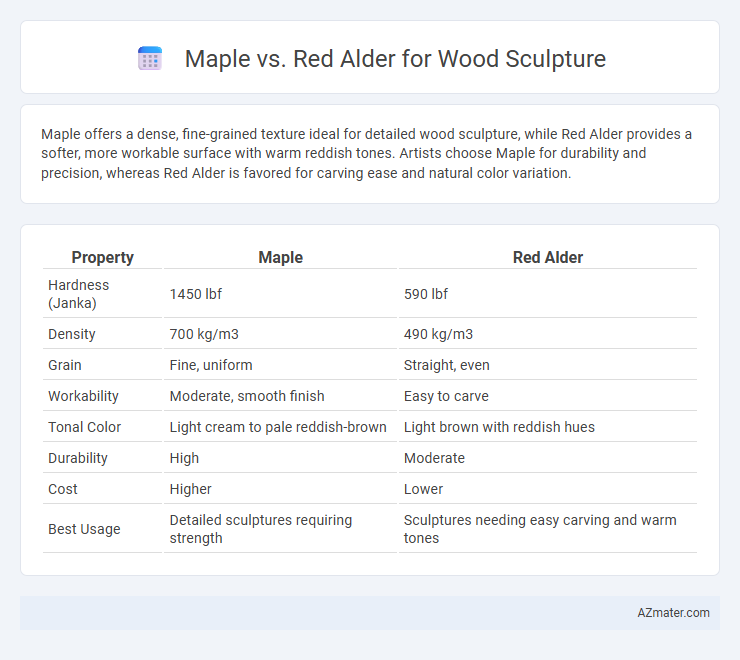Maple offers a dense, fine-grained texture ideal for detailed wood sculpture, while Red Alder provides a softer, more workable surface with warm reddish tones. Artists choose Maple for durability and precision, whereas Red Alder is favored for carving ease and natural color variation.
Table of Comparison
| Property | Maple | Red Alder |
|---|---|---|
| Hardness (Janka) | 1450 lbf | 590 lbf |
| Density | 700 kg/m3 | 490 kg/m3 |
| Grain | Fine, uniform | Straight, even |
| Workability | Moderate, smooth finish | Easy to carve |
| Tonal Color | Light cream to pale reddish-brown | Light brown with reddish hues |
| Durability | High | Moderate |
| Cost | Higher | Lower |
| Best Usage | Detailed sculptures requiring strength | Sculptures needing easy carving and warm tones |
Introduction to Maple and Red Alder in Wood Sculpture
Maple and Red Alder are popular choices in wood sculpture due to their unique grain patterns and workability. Maple offers a dense, fine texture that excels in holding intricate details and smooth finishes, making it ideal for precision carving. Red Alder provides a softer, more pliable surface with a warm reddish hue, favored for its ease of shaping and quick staining response in sculptural projects.
Wood Grain and Texture Comparison
Maple wood features a fine, consistent grain with a smooth texture, making it ideal for detailed wood sculpture and intricate carving. Red Alder displays a straighter, more open grain with a slightly coarser texture, offering easier workability but less fine detail retention. The choice between Maple and Red Alder depends on the desired level of detail and finish in the wood sculpture.
Workability: Carving and Shaping Ease
Maple offers a dense, fine-grain texture that allows for detailed carving but demands sharper tools and more effort due to its hardness. Red Alder is softer and more forgiving, making it ideal for beginners or complex shapes requiring smooth, precise cuts with less tool resistance. The ease of shaping Red Alder often results in faster project completion with a lower risk of chipping or tearing compared to Maple's tougher surface.
Strength and Durability Factors
Maple offers greater hardness and density, making it highly resistant to dents and wear, ideal for detailed wood sculpture requiring longevity. Red Alder, while softer and easier to carve, provides moderate durability but may be more prone to surface damage over time. For sculptures exposed to frequent handling or environmental stress, maple's superior strength and durability factors make it the preferred choice.
Color and Finishing Qualities
Maple features a pale, creamy color that darkens slightly with age, offering a smooth, fine grain ideal for detailed wood sculptures and a sleek, polished finish. Red Alder presents a warmer, reddish-brown hue with subtle grain patterns, providing a rich, natural appearance that enhances stain absorption and creates vibrant, lasting finishes. Both woods respond well to sanding and sealing, but Maple's uniform texture allows for a more refined and consistent finish, while Red Alder's color depth adds warmth and character to finished pieces.
Weight Differences and Handling
Maple wood is significantly denser and heavier than red alder, with a typical density of about 700 kg/m3 compared to red alder's lighter 510 kg/m3, making red alder easier to handle and maneuver during intricate wood sculpture projects. The weight difference influences tool fatigue and precision, as lighter red alder allows for longer carving sessions with reduced strain. Sculptors often prefer red alder for detailed work needing agility, while maple, being sturdier, suits pieces requiring durability and a more robust finish.
Cost and Availability
Maple is generally more expensive than red alder due to its hardness and widespread use in fine woodworking, making it a premium choice for wood sculpture. Red alder offers greater availability on the West Coast of the United States and is more cost-effective, appealing to sculptors seeking a softer, easier-to-carve wood. The price difference and regional availability often influence the decision between maple's durability and alder's affordability and ease of access.
Suitability for Detailed Designs
Maple offers a fine, tight grain that enhances its suitability for detailed wood sculpture, allowing for precise carving and smooth finishes. Red Alder provides a softer texture with a more open grain, which may be less ideal for intricate designs but easier to work with for larger, less detailed forms. Artists seeking sharp definition and durability often prefer Maple, while Red Alder suits sculptures emphasizing organic shapes and softer edges.
Environmental Impact and Sustainability
Maple wood, sourced primarily from North American forests, presents moderate environmental impact due to responsible forestry practices and its slower growth rate, which necessitates careful management to ensure sustainability. Red Alder, popular in the Pacific Northwest, regenerates quickly and is often harvested from second-growth forests, making it a more sustainable option with lower ecological footprint for wood sculptors. Both species offer durability and workability, but Red Alder's rapid renewability offers a distinct advantage in minimizing deforestation and supporting eco-friendly sculpture projects.
Choosing the Right Wood for Your Sculpture Project
Maple offers a fine, tight grain and durability ideal for detailed wood sculptures requiring a smooth finish, while Red Alder provides a softer texture that is easier to carve and more forgiving for beginners. Choosing the right wood depends on the sculptor's skill level and the desired sculpture characteristics, with Maple preferred for intricate designs and Red Alder suited for expressive, rougher forms. Both woods respond well to staining and finishing, but Maple's hardness ensures longevity in polished pieces, whereas Red Alder's moderate hardness allows for quicker shaping and agility in creative adjustments.

Infographic: Maple vs Red Alder for Wood Sculpture
 azmater.com
azmater.com